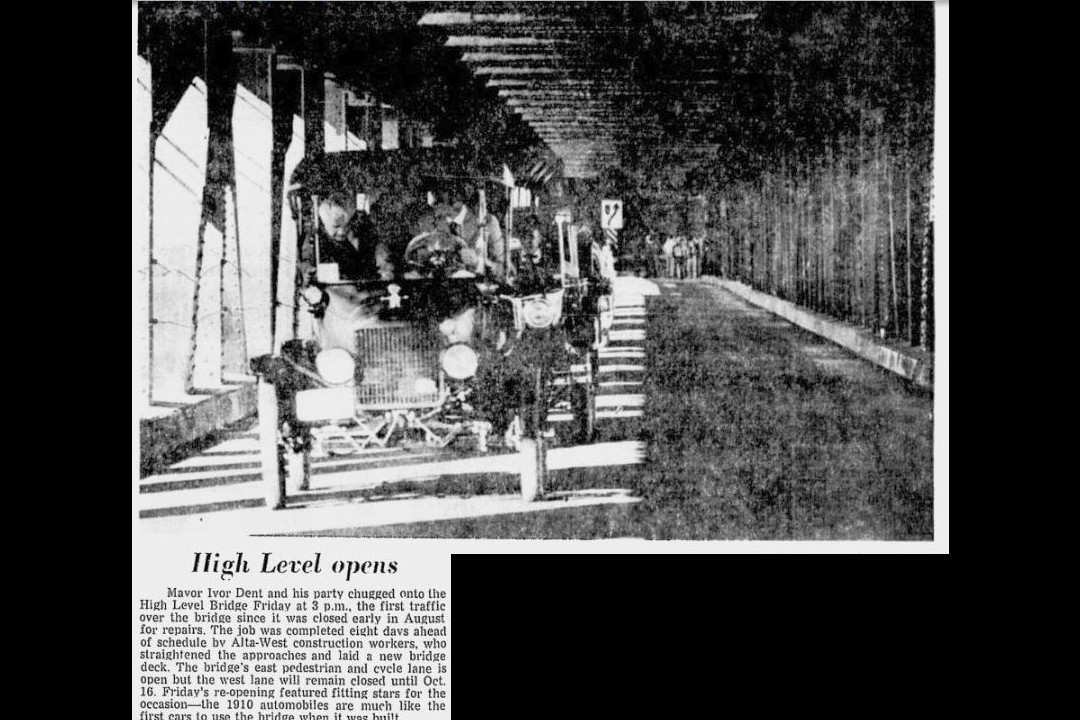On this day in 1971, one of Edmonton's most enduring landmarks reopened after reconstruction work.
That year, the High Level Bridge was shut down for several months to straighten vehicle approaches to it and replace the deck. To celebrate the reopening of the vital crossing, then-mayor Ivor Dent drove across the bridge in a car from the 1910s, linking to the bridge's original opening in 1913.
The High Level Bridge marked a turning point in Edmonton's history. The Canadian Pacific Railway was a vital link to the rest of Canada, but its tracks stopped short of the North Saskatchewan River in what was then the town of Strathcona. Edmonton's survival depended on moving people and goods across the river easily. In 1904, then-mayor William Short and a few business leaders met with CPR vice-president William Whyte (and yes, he's who the avenue is named after) to discuss building a new bridge. Newspaper reports noted that Whyte was "very favourable" to the idea of building a bridge.
Edmonton residents were favourable, too. In 1909, they voted overwhelmingly in favour of a bridge agreement between Edmonton and the CPR. The agreement created an ambitious project, as Edmonton politicians wanted a bridge for motorists as well as a train bridge. Fittingly, the High Level Bridge was the first in Canada designed to handle four modes of transportation: Trains, streetcars, automobiles, and pedestrians. As such, it was constructed to be strong, stable, and durable. More than 500 workers laboured on the project, and four died during construction. Work was briefly halted in 1912 during a strike by steelworkers seeking better pay and shorter hours.
When the High Level Bridge opened in 1913 it contained 7,700 tonnes of steel, was held together by 1.4 million rivets, and was covered in 19,000 litres of black paint. The first train crossed the bridge in June 1913, and the first streetcar followed that August. Drivers of automobiles, however, had to wait. There was a dispute over the final payment for the bridge and CPR barricaded access to automobile traffic until October, when it was paid an outstanding $37,000.
Since then, the High Level has been one of the main arteries connecting the city on either side of the river. It has undergone many rehabilitations and modifications over the years. The ways Edmontonians have crossed its spans have changed, too. In 1951, streetcar traffic stopped(and fortunately brought back by the Edmonton Radial Railway Society in 1997.) In 1989, the CPR trains stopped crossing the bridge. In 1980, two-way vehicle traffic was switched to southbound one-way traffic. And when the City of Edmonton took over full ownership of the High Level in 1994, they added a new pedestrian walkway and cycle track on the west side.
At one time, the city considered swapping the bridge's black paint job to gold to celebrate Canada's centennial. Luckily, that plan was scrapped. When it came time to celebrate Alberta's 75th anniversary in 1980, a much more realistic plan was devised — to turn the High Level Bridge into an artificial waterfall taller than Niagara Falls.
A more sombre side of the High Level's place in Edmonton was captured in a documentary by filmmaker Trevor Anderson in 2010. His film explored the bridge's history and the many suicides that have occurred from its heights. The film screened at the Toronto International Film Festival, Sundance, and others, and led to the city building better suicide prevention measures.
Just like back in 1971, Edmontonians are again facing a lengthy closure of the High Level. It's set to close down for a full three years for repairs starting in 2027. And it's one of several aging bridges set to be closed as the city repairs them in the coming years.
This clipping was found on Vintage Edmonton, a daily look at Edmonton's history from armchair archivist @revRecluse of @VintageEdmonton.

